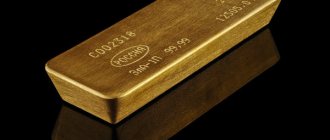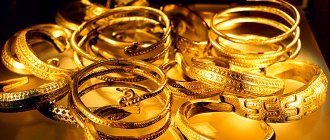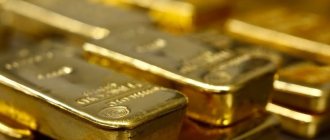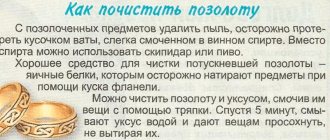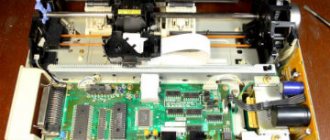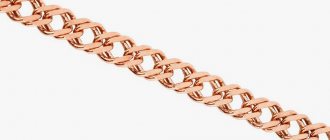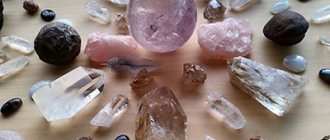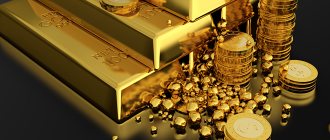Unfortunately, even when buying gold in expensive stores with a good reputation, it is not possible to be 100% sure of its quality. There are many ways to test gold that can be done at home, but they are all unreliable and cannot be completely relied on. In a workshop setting, a gold reagent is used for testing.
Testing gold with a reagent
Method of using reagents
Three types of reagents are used to test gold:
- acidic or standard;
- chlorine gold;
- potassium iodide.
Depending on the reagent used, it will take different times to determine the sample. Potassium iodide acts the fastest - 2-5 seconds. The slowest reaction is for the acid reagent intended for gold samples above 750 and the metal itself.
Acid reagent for determination of gold and platinum
In order to determine by eye which reagent is needed, you need to know some of the characteristics of gold. The higher the standard, the softer the metal. The density will be higher for gold of higher purity. In order to determine the density of a metal, it is necessary to weigh the product on a scale and then in a liquid. If we divide one value by another we get density. Next, to determine the sample, use the following method:
- If the gold content is about 37 percent, which corresponds to 375 standard, then the metal is first tested with gold chloride, and then with a reagent for 375 standard.
- For the 500th sample, the same order is used - gold chloride, then the reagent for this sample. Since the 500 sample most often represents the 585 sample, but slightly contaminated, it can therefore be additionally tested with an acid reagent for this sample.
- Gold alloys that are white in color and contain supposedly up to 60% gold are called gold chloride.
- Gold alloys of 750 standard, including white gold - with a reagent up to 750 standard, you can check with gold chloride to determine whether the product is a gross fake.
- Alloys that contain more than 80% gold are treated with a solution of potassium iodide, as well as with 750 standard, it is possible to clarify using gold chloride.
Care, cleaning and storage of gold-plated items
In order for your jewelry to last as long as possible, you must follow a few simple rules for caring for gold plating.
| Wearing | Be sure to remove gold-plated jewelry before any contact with water (shower, swimming pool, washing dishes) or sports activities. Avoid contact with cosmetics. Don't forget that everyday wear shortens their service life. |
| Storage | Store only in a separate box or fabric bags so as not to damage the layer with other decorations. |
| Cleaning | Clean only with a soft cloth without using abrasives. If dark spots just appear, just wipe with ordinary vinegar and rinse in water. The shine will help return the egg white (after it you will also need to rinse in clean water). Once a year, items should be taken to a jeweler for professional cleaning. |
Despite the fact that sooner or later the coating wears off, it can always be renewed in a jeweler’s workshop.
Acidic reagents
All acid reagents have the same type of effect; they leave a light spot on the metal of the sample for which they are intended, or do not react at all. They also do not react to metal of a higher standard and leave a brown spot if the sample is less than that for which the reagent is intended. In its preparation we use:
- nitric acid density 1.4;
- hydrochloric acid, density 1.19;
- distilled water.
For different gold samples, solutions are prepared in the following proportions:
| Try | Nitric acid | Hydrochloric acid | Water |
| 375 | 0.595 | 0.405 | |
| 500 | 1 | ||
| 583/585 | 0.46 | 4 drops | 0.54 |
| 750 | 0.593 | 0.011 | 0.396 |
| 833 | 0.687 | 0.013 | 0.3 |
| 900 | 0.692 | 0.013 | 0.295 |
| 958 | 0.787 | 0.02 | 0.193 |
The acid reagent for 500 gold can also be considered universal for any sample. It is a pure nitric acid that will react to all types of gold below 583 purity. It is the cheapest and most readily available. On all alloys containing less than half gold, bubbles will appear under the drop. The lower the sample, the more intense the release will be.
If there is no gold present at all, the reaction will occur instantly and a green foam will appear, which will be accompanied by hissing. On silver of a low standard it will leave a grayish spot, and with a standard below 800 the reaction will be the same, with bubbles. On silver below 600 fineness, nitric acid will boil. Such a reagent is often used as a starting reagent for the approximate determination of the metal being studied.
How not to determine a sample
When buying gold secondhand, even from a friend, it is advisable to use as many methods as possible to verify its authenticity. Restrictions apply to methods that may cause irreparable damage to the product or the health of the examiner. Naturally, you should not find out that inside the ring, cutting the product in half, breaks off any parts. After this, its jewelry value becomes zero. This is no longer a decoration, but a scrap.
Old-fashioned method for teeth
The softness of gold explains the ability to leave teeth marks on its surface. This method is not good for tooth enamel. When biting, microcracks appear on it, which can lead to the development of caries or tooth destruction.
By the way, this method does not provide a 100% guarantee of protection against counterfeiting. Aluminum and lead also retain dental marks. Often the print cannot be corrected or polished.
The jewelry and teeth will be hopelessly damaged. And for what?
Chlorine gold
Gold chloride is often used to test products whose fineness and composition are unknown. It is most effective when you need to identify fakes, for example, if the product is only coated with a layer of gold or there is no metal at all. This reagent is used if it is necessary to test 500 and 583/585 samples of gold.
Chlorine gold
The gold chloride reagent is not only used for determining gold; it can also be used to determine other types of precious metals and alloys. In order to carry out such an analysis, a drop of the reagent is applied to the surface of the metal being tested and waited. After some time, a spot of a certain color forms, by which they determine what kind of metal they are dealing with.
| Metal color | Spot color | Reaction time | Detectable metal |
| White | Dark green | Up to 2 sec. | High sterling silver |
| Yellow to dark yellow, accompanied by gas evolution | Up to 2 sec. | Aluminum | |
| Black | Approximately half a minute | Tin | |
| Grayish white | Has no effect | 30–40 sec. | Platinum |
| From yellow, quickly becomes very dark | Up to 2 sec. | Zinc | |
| Bluish white | Dirty yellow | Up to 2 sec. | Lead |
| Yellow | Has no effect | Up to 2 sec. | High-grade gold alloyed with silver |
| Chestnut | Up to 6 minutes | Low-grade alloys of gold with silver and copper | |
| Black | Up to 2 sec. | Brass | |
| Pale yellow | Black | Up to 2 sec. | Low-grade silver, in a ligature - copper |
| Red | Has no effect | Up to 2 sec. | High grade gold alloy. The ligature contains copper |
| Golden | Up to 6 minutes | Low grade gold alloyed with copper | |
| Black | Up to 2 sec. | Copper |
The lower the gold grade, the darker the stain will appear on the surface of the metal. On gold of the standard and most common standard 585, gold chloride will give a brown stain, on white gold of the same standard - an orange one. At 500 it is dark chestnut; at 375 gold chloride will leave a green spot. This reagent interacts well with gold and silver and has no effect on platinum and platinum group metals. It also reacts poorly with some types of steel.
What is gilding
Gold plating is a thin layer of gold that can hide almost any material. Its thickness can be from 1 to 20-25 microns, and the object becomes practically indistinguishable from gold. The method is used not only in jewelry, but also in architecture, design and even cosmetology.
Brief history of appearance
The art of gilding luxury items first appeared several thousand years ago in Ancient Egypt. It was he who became the first country in which gold mining took on an industrial scale. Since all the mines belonged to the pharaoh, it is not surprising that household items of the ruling family were the first to be gilded.
There is an alternative version that claims that the practice of gold plating originated in China. However, a simple comparison of historical facts speaks in favor of Egypt. The gold-plated sarcophagi of the Egyptian pharaohs date back more than 5,000 years, while in Lao Tang (the province of China considered the birthplace of gilding), thin gold plates have only been produced for about 2 millennia.
The art of gilding, having passed through the Middle East and reached Ancient Rus', received a significant impetus for development and reached a completely new level. It was in Rus' that gold became not just a sign of status and luxury, but also a symbol of faith and divine light.
Expert opinion
Vsevolod Kozlovsky
6 years in jewelry making. Knows everything about samples and can identify a fake in 12 seconds
The popularity of gilding, so beloved by Russian people, led to the creation of an original school, the development of its own methods and secrets. Gilding masters took boys from a very early age to teach them all the subtleties of their profession. And only a few of them actually reached the heights of mastery.
The next step in the development of art is the merit of architects, primarily Bartolomeo Rastrelli. It was he who brought into fashion the Baroque style, which is characterized by gilding not only furniture, but also stucco.
Discovery of the galvanic method by B.S. Jacobi made gilding jewelry safer and easier in the 19th century. Electroplating has taken the technique of applying gold plating to a new level.
Potassium iodide solution
This solution is used to test high purity gold alloys, as well as to identify good counterfeits, that is, those made from alloys that are inert to most substances. The solution works like this:
- On an alloy with a gold content above 90%, the reagent forms a bright red spot.
- On gold alloys with a gold content of 80 to 90% there is a burgundy stain. This gold alloy is often found in scrap left over from dental crowns or dentures.
- On counterfeits made from alloys that are highly resistant, a black or green spot forms, but turns black. The reaction is accompanied by the release of bubbles.
Gilding at home
When using gilding technology, you can restore the former attractiveness of almost any jewelry made of copper or silver. Products with gilding are used in a variety of ways, most often they become decoration. Gilding at home can be carried out using a variety of technologies. You can coat items made of silver or other alloys with gold, the main thing is to know all the features of the process. Restoring gilding is best done at home using special substances and equipment.
Laboratory tests
How to test gold using improvised and semi-professional methods was discussed earlier. However, there are more accurate and expensive ways to find out whether a product is genuine. Such studies are carried out in specialized laboratories using various instruments.
- Research can be carried out using electronic testers, which can be purchased at home, but it will not be so cheap. The tester scans the product and then displays the degree of purity of impurities.
- Checking a gold product can also be done using X-rays, which make it possible to find out about all its components. Such studies are carried out exclusively in laboratories and are quite expensive.
- Assay analysis allows you to determine the purity of gold in large items. Gold is tested by separating a small part from the product, which is subsequently alloyed with lead and silver. Lead and silver collect the pure gold together, after which the resulting alloy is weighed to determine the amount of pure gold originally included in the composition. This type of research is not suitable for gold jewelry as it is too small.
Gold is tested in various ways: methods where the use of improvised means is sufficient, laboratory and semi-professional methods that use nitric acid or a touchstone.
It all depends on how much effort and money you are willing to spend on checking. In the end, you can always go to a pawnshop, where a specialist will check the gold and determine the authenticity of the product for sure and, moreover, will not require a lot of money for it.
